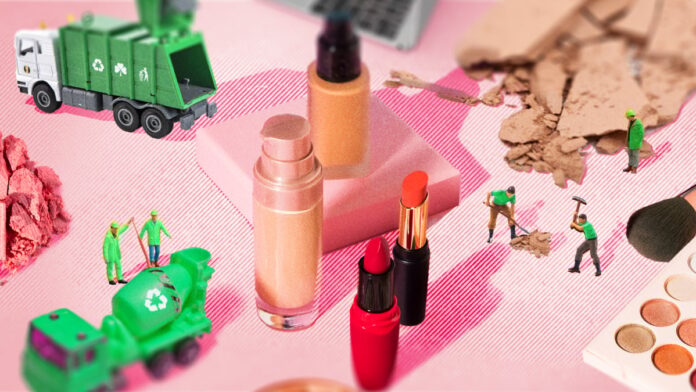Table of Contents
When you really think about it, life is just a constant cycle of acquiring new stuff and figuring out what to do with the old stuff. And when there’s not a one-size-fits-all way to properly get rid of that old stuff, clutter happens.
Most of us have been conditioned to recycle some common everyday materials, but curbside recycling isn’t too helpful past paper, metal, glass, and certain types of plastic. Even then, a shockingly low percentage of recyclable items are actually recycled. I digress.
Other personal items, like clothes and shoes or electronics and batteries, are more confusing to deal with. Can they be recycled, or is throwing them away the only option?
Texas resident used Apple AirTags to track her recycling. It ended up in the middle of nowhere.
Perhaps you’ve Googled “how to recycle insert item here” just to be given some vague instructions like “Check locally.” You’ll quickly learn that most municipal recycling programs don’t cover much beyond trash-like recyclables. Past that, it can be hard to pin down actionable ways to downsize sustainably.
Fortunately, getting rid of hard-to-recycle stuff isn’t so mysterious. In many cases, there actually are solid options for recycling all of that junk crammed under your bed and into old shoeboxes. Once you hone in on a certain category — beauty empties, coffee maker pods, smartphones, old chargers — there’s usually a super straightforward answer for how to recycle said items. In fact, you can often find easy (and free) drop-off or mail-in programs.
It just takes a little more effort than plopping them in the curbside recycling bin and hoping the recycling fairy whisks it away to the right place. That’s called wishcycling, or aspirational recycling, and I would definitely sleep better at night if I were still blissfully living in “everything can be recycled” ignorance.
So, to help you recycle electronics, clothing, beauty packaging, and other awkward items, let’s break it down in the most candid way possible.
How to recycle electronics
E-waste is a doozy of a rabbit hole. As with plastic pollution, a good chunk of e-waste (the umbrella term for improperly discarded electronic devices) comes from big tech corporations. The U.S. Public Interest Research Group estimates that we generate around 6.9 million tons of e-waste each year. Of that, less than 18 percent is recycled properly.
But as a species that has treated our personal devices as extra limbs for almost two decades, it’s also our personal responsibility to deal with our old devices in the most sustainable way possible. Not only do electronics in landfills leak dangerous toxins into the ground, but it’s also a missed opportunity to recover metals and precious rare earth minerals.
To be fair, people aren’t exactly given clear instructions on how or where to safely recycle old devices. A recent CNET survey found that over 30 percent of U.S. adults hold onto old phones, tablets, and chargers simply because they don’t know what to do with them.
Cellphones, laptops, TVs, and more
You’re probably aware of the trade-in promos that your smartphone carrier offers. Similar incentives exist for devices like iPads and tablets. But even if the device in question isn’t exactly in trade-in or sell-on-Mercari condition, there are still super accessible ways to recycle the gadget without smashing it for parts.
Best Buy actually has a super-expensive in-store electronics recycling program. Items accepted in store include TVs, computers and routers, audio gear (from headphones to old CD or cassette players), cameras and camcorders, and video game controllers. A household can recycle up to three items per day. You can also pay Best Buy to come haul away larger items, like an old fridge or treadmill.
No Best Buy store nearby? The company also offers a mail-in recycling service.
Once received, recyclers disassemble the tech to pull out and properly get rid of ozone-depleting chemicals like PCBs, mercury, and insulation, then separate materials like plastic, glass, and metal to be repurposed when possible.
Samsung device owners can also conduct a similar zip code search to find participating Samsung e-cycling drop-off centers. They pop up all over in retail stores like Best Buy and Staples, and sometimes even at your local solid waste authority. Before recycling, check to see if Samsung will offer credit to trade in your old device — yes, cracked screens count.
Mashable Top Stories
Apple offers its own recycling program for old Apple devices, and you can even get a prepaid shipping label.
Chargers, cables, and dongles
That harrowing nest of old cords in your basement or junk drawer is growing more powerful by the day. Rather than continue feeding it, you can recycle old chargers and similar connectors through the Best Buy recycling program mentioned above. Apple’s service also takes old Apple chargers.
Batteries
Call2recycle is a nationwide battery recycling program that offers free battery recycling at partnering stores like The Home Depot, Lowe’s, and Staples. Head to the website and enter your zip code to find the closest drop-off location to you. Note that not all participating locations accept every type of battery, so be sure to check the box.
If no collection boxes are popping up in a practical distance, call2recycle also has a mail-in battery recycling program — though at $80 for the smallest battery and cellphone recycling kit, it’s not exactly the cheapest route.
How to recycle clothes and shoes
There are paths forward for both gently-worn clothes and too-worn-to-donate clothes that aren’t merely forcing them upon Goodwill and hoping they squeeze their way onto an overflowing rack.
If the clothes are in decent enough condition, consider trying to sell them online. You don’t need a ton of followers to get eyes on your items on Depop, Mercari, or Poshmark — just take well-lit, clear photos, write a detailed and honest description, and add a price. (Check out my full guide to selling your stuff online.)
If you don’t feel like getting into online resale, there are a few mail-back options for repurposing old clothing. Give Back Box is a non-profit that partners with a slew of small charities from which you can choose to send your items, depending on what they need (i.e., kids’ shoes or gently used women’s clothes). Once you find a good fit, Give Back Box will just ask for $20 to cover the pre-addressed shipping label and the weight of the box. Then, pack your items in any random box you were going to recycle anyway, and send it off.
Of course, there are always the straggler pieces of clothing that are probably too worn to donate. Sustainable clothing brand Girlfriend Collective has partnered with SuperCircle (a growing textile recycling platform) to facilitate ReGirlfriend, an amazingly easy mail-in garment recycling program. Shipping labels are free, and you can pack multiple pieces in each bag, regardless of brand. As a “thank you” for not contributing to the pile of textiles in landfills, Girlfriend offers credits to girlfriend.com.
How to recycle random household items
Ah, Swiffer pads. The ubiquitous mopping and dusting thingamabob that, turns out, is a pain in the ass to recycle. That’s just one of a horde of everyday household items that folks mindlessly trash. But what’s the alternative?
Well, my initial suggestion would be to retire the Swiffer and buy a robot vacuum and mop combo. Even if you insist on keeping the Swiffer as backup for some pesky corner cleaning (though I have a robot mop recommendation for corner cleaning), a robot vacuum that can mop at least minimizes your Swiffer use.
When you do collect enough used Swiffer refills, you can mail them to TerraCycle: a mega-recycling business that gives average consumers an easy way to recycle everyday items that don’t play well with curbside recycling. Its free mail-back system covers a ton of household items, with the cost of shipping labels funded by participating brands like Swiffer, Tide, Brita, Black + Decker, and Febreze.
Coffee pods
Nespresso has a ton of drop-off points across the country to recycle pods. You can also request free pre-labeled recycling bags on Nespresso’s website to fill and eventually mail back to Nespresso. (Each mailer can hold up to 200 Original Line pods or 100 Vertuo pods.)
Keurig has a similar setup, but it’s not free — and Keurig only describes the program through the lens of office use (like “use the small box in offers that brew 24 K-Cups or less in day”) with no mention of keeping a box at home in a Keurig-heavy household.
How to recycle beauty and bathroom stuff
Makeup and skincare
Though much of it looks recycling-friendly, most beauty packaging isn’t. Many bottles that feel like glass aren’t the same type of glass as a beer bottle or jelly jar, and many containers that feel like plastic are actually a peculiar type of mixed plastic, which doesn’t fall under the number system used to sort at recycling plants. (This includes the pain in the ass plastic pump.)
The presence of the triangle of arrows symbol is misleading, and doesn’t automatically mean that said material can be recycled. This is one time when checking locally is crucial — just Google what plastic numbers are accepted in your area. (For example, I live in Philadelphia, and plastics 1, 2, and 5 are cleared for curbside here.)
For beauty empties with a non-accepted number or no number at all, beauty-centric take-back programs are the move. Both Ulta and Sephora have partnered with Pact Collective to offer recycling bins for your empties in a ton of stores across the country. Nordstrom has a partnership with TerraCycle, offering a similar in-store drop-off option for beauty packaging.
Project Beauty Share is one great option for giving opened skincare products a new home, as long as they’re not expired. Accepted gently-used beauty items include moisturizers and serums, cleansers, body lotions, shower gels, perfumes, and sunscreens. Squeeze tubes of foundation or primer and pressed eyeshadow, blush, and highlighter are accepted if they’re open but only barely used.
Hair tools
Beauty brand Mane repurposes hair tools also partners with Pact Collective to take your unwanted hot hair tools, whether they work or not. Hair tools in good working condition will be properly sanitized and shipped off to be distributed to young women through Project Glimmer, an organization dedicated to helping end gender and racial inequality for women and girls. Hair tools that don’t work will be taken apart and processed for proper recycling. Labels are prepaid by Mane, as long as you use your own box.
Razors
Sure, most disposable razor handles are plastic, and razor blades are metal. Both materials are recyclable separately, but mixed materials like that bar disposable razors from being curbside recyclable. Luckily, TerraCycle has a free recycling program for common shaving brands like Gillette and Venus, from handles, to blades, to the bags the replacements come in. Consider keeping a separate receptacle to safely house a few months’ worth of used razors, then send them back to be properly taken apart and recycled. If people caught onto this, just think of the dent that could be put into the estimated two billion disposable razors thrown out each year.
Toothbrushes
The number of toothbrushes thrown out each year is just as grim. National Geographic clocks around one billion plastic toothbrushes ending up in landfills annually, and toothpaste tubes are a similar story. If you use Colgate, Arm & Hammer, or Tom’s of Maine toothbrushes, tubes, caps, and more, there’s a free mail-in TerraCycle program for that.
For old toothbrushes, electric toothbrush replacement heads, used flossers, and toothpaste tubes from Crest, Oral-B, or Fixodent, you can collect and mail those in for free through Oral-B’s direct recycling program.

